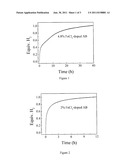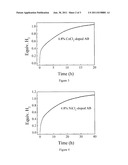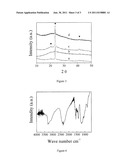Patent application title: METHOD OF SYNTHESIZING CRYSTALLINE POLYMERIC BORON-NITROGEN COMPOUND AND DEHYDROGENATION OF BORON-NITROGEN-HYDROGEN COMPLEX
Inventors:
Ping Chen (Dalian, CN)
Teng He (Dalian, CN)
Zhitao Xiong (Dalian, CN)
Guotao Wu (Dalian, CN)
Assignees:
Dalian Institute of Chemical Physics, Chinese Academy of Sciences
IPC8 Class: AC01B3514FI
USPC Class:
423285
Class name: Boron or compound thereof nitrogen and hydrogen containing ternary compound
Publication date: 2011-06-30
Patent application number: 20110158881
Abstract:
The present invention provides a method for synthesis of crystalline
polymeric boron-nitrogen compounds comprising a step of dehydrogenation
of a boron-nitrogen-hydrogen compound on catalyst, wherein the
boron-nitrogen-hydrogen compound is selected from the group consisting of
ammonia borane, metal amidoboranes, amine boranes or mixtures thereof,
and the catalyst is selected from the group consisting of transition
metals, transition metal salts or alloys.Claims:
1. A method for synthesis of crystalline polymeric boron-nitrogen
compounds comprising: dehydrogenating a boron-nitrogen-hydrogen compound
on catalyst, wherein the boron-nitrogen-hydrogen compound is selected
from the group consisting of ammonia borane, metal amidoboranes, amine
boranes and mixtures thereof, and the catalyst is selected from the group
consisting of transition metals, transition metal salts and alloys.
2. The method according to claim 1, wherein the polymeric boron-nitrogen compound has a composition of [NRR'BH2]n, or [R(NHBH2)2]n in which n≧2, the R and R' each independently represents one selected from the group consisting of H, Li, Na, K, Mg, Ca and organic groups -Me (methyl), -Pr (propyl), -Et (ethyl), and -Ph (phenyl).
3. The method according to claim 1, wherein the boron-nitrogen-hydrogen compound is ammonia borane.
4. The method according to claim 1, wherein said hydrogenating is conducted in solid or in solution.
5. The method according to claim 1, wherein the transition metal is at least one element selected from the group consisting of Group IB, Group IIB, Group IIIB, Group IVB, Group VB, Group VIB, Group VIIB and Group VIIIB in the Periodic Table of Elements.
6. The method according to claim 5, wherein the transition metal is at least one element selected from the group consisting of iron (Fe), cobalt (Co), Nickel (Ni), copper (Cu), ruthenium (Ru), rhodium (Rh), palladium (Pd), silver (Ag), platinum (Pt) and gold (Au).
7. The method according to claim 1, wherein the transition metal salt comprises at least one selected from the group consisting of organometallics, carbonates (CO.sub.3.sup.-), nitrates (NO.sub.3.sup.-), halides (X.sup.-), phosphates (PO.sub.4.sup.3-) and sulfates (SO.sub.4.sup.2-), acetates (CH2COOH.sup.-).
8. The method according to claim 1, wherein the alloy is a binary or multiple metal-metal alloy or a metal-metalloid alloy.
9. The method according to claim 8, wherein the alloy comprises at least one transition metal alloyed with at least one element selected from the group consisting of B, C and N.
10. The method according to claim 1, wherein a molar ratio of boron-nitrogen-hydrogen compound to the catalyst is in a range from 100,000:1 to 1:1.
11. The method according to claim 10, wherein the molar ratio of boron-nitrogen-hydrogen compound to the catalyst is from 1,000:1 to 5:1.
12. The method according to claim 1, wherein the method is conducted on a temperature range from -100 to 300.degree. C.
13. The method according to claim 12, wherein the temperature is from -20 to 150.degree. C.
Description:
[0001] This application claims the benefit of Chinese Patent Application
Number 200910248936.5 filed on Dec. 30, 2009, the disclosure of which is
hereby expressly incorporated by reference in its entirety and hereby
expressly made a portion of this application.
FIELD OF THE INVENTION
[0002] The present invention relates to the method of preparing a crystalline polymeric boron-nitrogen compound (hereinafter referred to as "B--N compound") via dehydrogenation of boron-nitrogen-hydrogen compound (hereinafter referred to as "B--N--H compound") in the presence of a catalyst.
BACKGROUND OF THE INVENTION
[0003] Recently, ammonia borane (NH3BH3, hereinafter referred to as "AB") has been paid much attention due to its high stoichiometric hydrogen content (19.6 wt %) to meet the need of "hydrogen economy". Dehydrogenation of AB is a three steps reaction, giving one equivalent H2 at each step. In the first step, polymeric aminoborane ([NH2BH2]n) as the main product is obtained with one equivalent H2 released around 110° C..sup.[1].
n N H 3 B H 3 → catalysts [ N H 2 B H 2 ] n + n H 2 ##EQU00001##
[0004] However, the polymeric aminoborane, which was generally described as polyaminoborane (hereinafter referred to as "PAB"), is actually a mixture of amorphous linear, branched and cyclic oligomers and polymers. At the same time, researchers used transition metal, acid, base and ionic liquid to catalyze dehydrogenation of AB in solution.sup.[2-5]. But the crystallinity of products was either amorphous or not mentioned. Heinekey et al. catalyzed dehydrogenation of AB by using (POCOP)Ir(H)2 in THF solution to obtain cyclic pentamer (NH2BH2)5.sup.[6]. However, the catalyst (POCOP)Ir(H)2 is a complex metal organic compound which is not convenient to get. No other reports were published about the formation of crystalline PAB from the dehydrogenation of AB.
[0005] As derivatives of AB, metal amidoboranes and amine boranes can also dehydrogenate under certain condition or on catalysts. However, no reports were published about the crystallinity of the post-dehydrogenated products through solid reaction.
SUMMARY OF THE INVENTION
[0006] Therefore, the present invention provides a method of synthesizing crystalline B--N compound through dehydrogenation of ammonia borane, metal aminoboranes or amine boranes using common and cheap chemicals as catalysts, such as, for example, transition metals, transition metal salts, and alloys.
[0007] According to one aspect of the invention, there is provided a method for synthesis of crystalline polymeric B--N compounds comprising a step of dehydrogenation of a B--N--H compound on catalyst, wherein the B--N--H compound is selected from the group consisting of ammonia borane, metal amidoboranes, amine boranes or mixtures thereof, and the catalyst is selected from the group consisting of transition metals, transition metal salts or alloys.
BRIEF DESCRIPTION OF THE DRAWINGS
[0008] FIG. 1 shows a graph of volumetric release measurement on 4.8 mol % FeCl2-doped AB at 60° C.
[0009] FIG. 2 shows a graph of volumetric release measurement on 2.0 mol % FeCl2-doped AB at 80° C.
[0010] FIG. 3 shows a graph of volumetric release measurement on 4.8 mol % CoCl2-doped AB at 60° C.
[0011] FIG. 4 shows a graph of volumetric release measurement on 4.8 mol % NiCl2-doped AB at 60° C.
[0012] FIG. 5 shows XRD patterns of crystalline cyclopentaborazane from post-dehydrogenated 4.8 mol % FeCl2 (a), CoCl2 (b) and NiCl2 (c)-doped AB and 2.0 mol % FeCl2 (d)-doped AB samples. (: cyclopentamer)
[0013] FIG. 6 shows infrared spectrum of cyclopentaborazane from post-dehydrogenated 4.8 mol % FeCl2 at 60° C.
DETAILED DESCRIPTION OF THE INVENTION
[0014] In the description, unless otherwise indicated, the term "B--N compound" means a compound mainly composed of boron and nitrogen atoms, the term "B--N--H compound" means a compound mainly composed of boron, nitrogen and hydrogen atoms.
[0015] The present invention provides a method for producing B--N compounds through catalytic dehydrogenation of B--N--H compounds. Specifically, the present invention provides a method for synthesis of crystalline polymeric B--N compounds comprising a step of dehydrogenation of a B--N--H compound on catalyst, wherein the B--N--H compound is selected from the group consisting of ammonia borane, metal amidoboranes, amine boranes or mixtures thereof, the catalyst is selected from the group consisting of transition metals, transition metal salts or alloys.
[0016] According to certain preferred embodiments, the polymeric B--N compound has a composition of [NRR'BH2]n, or [R(NHBH2)2]n in which n≧2, the R and R' each independently represents one selected from the group consisting of H, Li, Na, K, Mg, Ca and organic groups -Me (methyl), -Pr (propyl), -Et (ethyl), and -Ph (phenyl).
[0017] According to certain preferred embodiments, the B--N--H compound is ammonia borane.
[0018] According to certain preferred embodiments, the catalytic dehydrogenation is conducted in solid or in solution, more preferably in solid form. Preferably, the catalytic dehydrogenation is conducted at a mild condition. In case of solid dehydrogenation, the catalysts or catalyst precursors are dispersed in ammonia borane by using conventional techniques, such as, for example, stirring, ball milling or co-precipitation.sup.[7] method, in which co-precipitation method is preferred.
[0019] According to certain preferred embodiments, the transition metal is at least one element selected from the group consisting of Group IB, Group IIB, Group IIIB, Group IVB, Group VB, Group VIB, Group VIIB and Group VIIIB in the Periodic Table of Elements. More preferably, the transition metal is at least one element selected from the group consisting of iron (Fe), cobalt (Co), nickel (Ni), copper (Cu), ruthenium (Ru), rhodium (Rh), palladium (Pd), silver (Ag), platinum (Pt) and gold (Au).
[0020] According to certain preferred embodiments, the transition metal salt is selected from the group consisting of organometallics, carbonates (CO3.sup.-), nitrates (NO3.sup.-), halides (X.sup.-), phosphates (PO43-), sulfates (SO42-), and acetates (CH2COOH.sup.-).
[0021] According to certain preferred embodiments, the alloy is a binary or multiple metal-metal alloy or a metal-metalloid alloy. More preferably, the alloy is an alloy of at least one transition metal and at least one element selected from the group consisting of B, C and N.
[0022] According to certain preferred embodiments, the molar ratio of B--N--H compound to catalyst is in a range from 100,000:1 to 1:1, more preferably, from 1,000:1 to 5:1.
[0023] According to certain preferred embodiments, the method is conducted on a temperature range from -100 to 300° C., more preferably, from -20 to 150° C.
[0024] The B--N--H compounds are high hydrogen content materials, which should be conducted carefully. Thus, the operation of them is preferably conducted under inert atmosphere, for example, under an inert gas such as Ar or N2 among others.
[0025] Taking PAB as an example, the reaction mechanism and operation conditions are illustrated below. The formation of crystalline PAB from catalytic dehydrogenation of ammonia borane followed following reaction:
n N H 3 B H 3 → catalysts [ N H 2 B H 2 ] n + n H 2 n ≧ 2. ##EQU00002##
[0026] For [NH2BH2]n, preferably, n=2, 3, 4, 5, or 6.
[0027] The catalytic dehydrogenation of AB is carried out preferably in a closed system under inert gas or vacuum. The quantity of hydrogen release is preferably from about 0.5 equivalent hydrogen to about 1.5 equivalent hydrogen. The reaction time is preferably from about 1 hour to about 100 hours.
[0028] The products of polymeric B--N compounds are examined by X-ray diffraction and infrared spectrum as shown in FIGS. 5 and 6.
EXAMPLES
Example 1
[0029] 31.8 mg (2.5×10-4 mol) FeCl2 was put into 10 ml THF and sonicated for 20 min. Then, 159.8 mg (5×10-3 mol) AB was added into the FeCl2-THF solution or suspension. THF was removed immediately by a rotary evaporator at room temperature. 4.8 mol % FeCl2-doped AB sample was made. Samples were vacuumed overnight and then preserved below 10° C. to avoid self-decomposition. Volumetric release measurement on the 4.8 mol % FeCl2-doped AB sample was carried out under Ar atmosphere at 60° C. and the result was shown in FIG. 1. About 1.0 equivalent H2 was released from FeCl2-doped AB sample in about 40 hrs. Product was examined by XRD (X-ray Diffraction) and the result was shown in FIG. 5. The crystalline PAB was indentified as crystalline cyclopentaborazane.
Example 2
[0030] 13.1 mg FeCl2 was doped into 159.8 mg AB following the procedure of Example 1 to make 2.0 mol % FeCl2-doped AB sample. Volumetric release measurement on the FeCl2-doped AB sample was carried out under Ar atmosphere at 80° C. and the result was shown in FIG. 2. About 1.0 equivalent H2 was released from FeCl2-doped AB sample in about 12 hrs. Product was examined by XRD and the result was shown in FIG. 5. The crystalline PAB was indentified as crystalline cyclopentaborazane.
Example 3
[0031] 33.5 mg CoCl2 was doped into 159.8 mg AB following the procedure of Example 1 to make 4.8 mol % CoCl2-doped AB sample. Volumetric release measurement on the CoCl2-doped AB sample was carried out under Ar atmosphere at 60° C. and the result was shown in FIG. 3. About 1.0 equivalent H2 was released from CoCl2-doped AB sample in about 20 hrs. Product was examined by XRD and the result was shown in FIG. 5. The crystalline PAB was indentified as crystalline cyclopentaborazane.
Example 4
[0032] 33.5 mg NiCl2 was doped into 159.8 mg AB following the procedure of Example 1 to make 4.8 mol % NiCl2-doped AB sample. Volumetric release measurement on the NiCl2-doped AB sample was carried out under Ar atmosphere at 60° C. and the result was shown in FIG. 4. About 1.0 equivalent H2 was released from NiCl2-doped AB sample in about 20 hrs. Product was examined by XRD and the result was shown in FIG. 5. The crystalline PAB was indentified as crystalline cyclopentaborazane.
REFERENCES
[0033] [1] G Wolf, J. Baumann, F. Baitalow, F. P. Hoffmann, Thermochimica Acta 2000, 343, 19. [0034] [2] R. J. Keaton, J. M. Blacquiere, R. T. Baker, J. Am. Chem. Soc. 2007, 129, 1844. [0035] [3] F. H. Stephens, R. T. Baker, M. H. Matus, D. J. Grant, D. A. Dixon, Angew. Chem. Int. Ed. 2007, 119, 760. [0036] [4] D. W Himmelberger, C. W. Yoon, M. E. Bluhm, P. J. Carroll, L. G Sneddon, J. Am. Chem. Soc. 2009, 131, 14101. [0037] [5] M. E. Bluhm, M. G Bradley, R. Butterick, U. Kusari, L. G Sneddon, J. Am. Chem. Soc. 2006, 128, 7748. [0038] [6] M. C. Denney, V. Pons, T. J. Hebden, D. M. Heinekey, K. I. Goldberg, J. Am. Chem. Soc. 2006, 128, 12048. [0039] [7] T. He, Z. Xiong, G Wu, H. Chu, C. Wu, T. Zhang, P. Chen, Chem. of Mate. 2009, 21, 2315.
User Contributions:
Comment about this patent or add new information about this topic:



